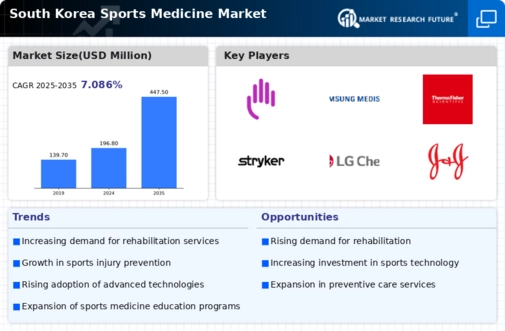Advancements in Medical Technology
Technological innovations in medical devices and treatment methodologies are significantly influencing the sports medicine market. In South Korea, the integration of advanced imaging techniques, wearable technology, and minimally invasive surgical procedures is enhancing the diagnosis and treatment of sports injuries. For instance, the adoption of MRI and ultrasound imaging has improved the accuracy of injury assessments, leading to better patient outcomes. The sports medicine market is likely to see substantial growth as these technologies become more accessible and affordable. Furthermore, the development of telemedicine platforms allows for remote consultations, which could potentially increase patient engagement and satisfaction, thereby driving market expansion.
Support from Government Initiatives
Government initiatives aimed at promoting health and wellness are playing a crucial role in the growth of the sports medicine market. In South Korea, various programs have been launched to encourage physical activity and provide resources for injury prevention and treatment. For example, the government has invested in sports facilities and health education, which has led to a reported 15% increase in public participation in organized sports. This support not only fosters a healthier population but also stimulates demand for sports medicine services. The sports medicine market stands to gain from these initiatives, as they create a conducive environment for healthcare providers to offer specialized services and products tailored to the needs of active individuals.
Growing Awareness of Sports Injuries
There is a notable increase in awareness regarding sports-related injuries among athletes and the general public in South Korea. This heightened consciousness is driving the sports medicine market as individuals seek preventive measures and effective treatments. Educational campaigns and media coverage have contributed to this awareness, leading to a reported 25% increase in consultations for sports injuries over the past year. As a result, healthcare providers are focusing on developing specialized programs and products tailored to address these injuries. The sports medicine market is thus positioned to expand, as both amateur and professional athletes prioritize their health and recovery, leading to increased demand for medical expertise and innovative treatment options.
Increased Participation in Sports Activities
The growing interest in sports and fitness among the South Korean population appears to be a primary driver for the sports medicine market. As more individuals engage in various sports, the demand for specialized medical services and products increases. According to recent data, approximately 60% of South Koreans participate in some form of physical activity, which correlates with a rising need for injury prevention and treatment solutions. This trend suggests that healthcare providers and sports medicine professionals must adapt to cater to a more active demographic, thereby expanding the market. The sports medicine market is likely to benefit from this increased participation, as it necessitates a broader range of services, including physiotherapy, orthopedic care, and rehabilitation programs.
Rising Incidence of Lifestyle-Related Injuries
The increasing prevalence of lifestyle-related injuries, particularly among the urban population in South Korea, is emerging as a significant driver for the sports medicine market. As sedentary lifestyles become more common, individuals are experiencing a rise in musculoskeletal disorders and injuries related to physical activity. Reports indicate that lifestyle-related injuries have surged by approximately 30% in recent years, prompting a greater need for medical intervention. This trend suggests that the sports medicine market must adapt to address these emerging health concerns, focusing on rehabilitation services, preventive care, and educational programs to mitigate the risks associated with an active lifestyle.

















Leave a Comment